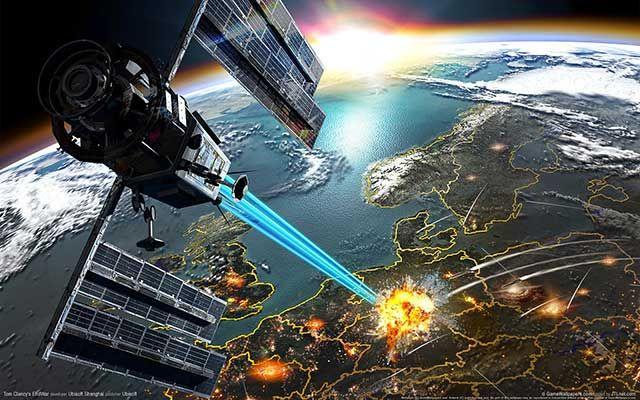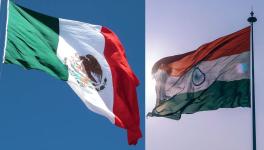US Abandons Open Skies for New Age Space Weapons

Image for representational use only.
With the US deciding to walk out of the Open Skies Agreement, it is signalling to the world that it intends to return to the days of Pax Americana that existed post-World War 2, when it was the sole possessor of nuclear weapons. It has already walked out of the Anti-Ballistic Missile (ABM) Treaty in 2002 under George Bush Junior, and the Intermediate-Range Nuclear Forces Treaty (INF) under current US President Donald Trump. The only nuclear arms control treaty that still remains in place, is the New Strategic Arms Reduction Treaty (START), which provides a rough limit and parity on the US and Russia’s nuclear arsenals. Its days also seem to be numbered, as it expires on 5th February, 2021, leaving very little time for any serious discussion.
The Trump administration is now considering a resumption of nuclear tests, which would be in violation of the Comprehensive Nuclear Test Ban Treaty or CTBT. Is that another treaty destined for the waste paper basket? This is apart from other nuclear restraint treaties that the US signed with other states such as North Korea and Iran, and subsequently tore up unilaterally, prompting the view that the US is no longer treaty capable.
Marshall Billingslea, who is the US official arms-control negotiator, has talked about how the US intends to spend Russia and China into oblivion, as it had done with the Soviet Union earlier. Obviously, as an arms-control negotiator, he is a fitting successor to Bolton, whose chief claim to fame is wielding a hammer to smash all arms control agreements.
The US is also weaponising space, and has a new Space Command. Last year, Trump, speaking in the Pentagon, said, “A space-based missile defence layer … is going to be a very, very big part of our defence...And obviously of our offence.”
So what is the Open Skies Agreement? The treaty permits all its 35 signatories – the US, Russia and other NATO allies – to fly over each other’s territories. Effectively, it allows official military reconnaissance flights.
So why does the US want to exit a treaty that makes it possible to launch surveillance flights over Russia? This is a question that even military experts are hard put to answer. One reason given is that the US has complete imaging capabilities over Russia using its satellites, and does not need old fashioned aircraft-based methods. Therefore, the US is denying Russia overflights over its territory in the belief that Russia will not be able to match the US space-based surveillance capabilities. And if it tries to match the US, it is back to the Billingslea-Trump game; the US will either win the new weapons war, if not, then the economic war. But war it is.
There is also a second target of the US in walking out of the Open Skies Agreement. European countries are very much a part of this agreement, not just the US. The US did not even talk to its NATO allies before the decision to abandon this Agreement. The US wants to deny any strategic independence to its NATO allies. If the Open Skies Agreement now fails, as Russia has no incentive to offer other NATO countries overflights when it has none over the US, other NATO allies will be even more dependent on the US for information. This is a strike as much against its own NATO allies as against Russia.
During the initial negotiations for the New START, Trump and Billingslea are talking about brining in China in order to limit its nuclear arsenal as well. This was also one of the arguments given when the US abandoned the INF Treaty.
So let us look at the respective nuclear arsenals of countries. Currently, the United States and Russia have more than 6,000 total nuclear warheads each, while China has about 300 (Arms Control Association’s Factsheet). So, any agreement that brings in China can only increase its voluntary limit and not reduce it! Just for the record, France also has 300, with the UK at 200, and India and Pakistan around 150 each. Israel has about a 100, and Democratic Peoples Republic of Korea has about 30.
If we sum up, the US believes, that since the 90’s, it is the sole global hegemon. Any arms control treaty hinders the exercise of its military might. It recognises that it can no longer control the global economy, where China is already in the process of overtaking the US, give or take a decade or two. A trade agreement that follows the rules, even if the rules were put in place in the 90s by the US and its allies in the World Trade Organisation (WTO), no longer helps the US. Faced with competition not only from China, but from a range of other countries, it has fallen back on its military power as its key “bargaining” strategy: ‘Agree to what we say or else! And if you try to match us militarily, we will bankrupt you as we did with the Soviet Union’.
Without entering into the discussion on if the myth of the Soviet collapse due to competing militarily with the US is correct, let us look at what options that Russia and China have. Putin has made clear that Russia will not accept that the US can become the global overlord, and dictate to it and other countries. The Yeltsin period of US dominance over Russia must still rankle. Neither will China.
The US change in tack with respect to China is a part of what is now being called hybrid war—military threats coupled with economic actions—to inflict enough damage that China is forced to sue for peace, accepting its subordinate status.
That is why China and Russia have come together. China’s economic strength and Russia’s military capabilities provide a formidable opposition to US dominance. Russia’s technological strength in missiles, submarines, and radar have always been cutting edge. The S-400 defence shields with radar arrays and defensive missiles are still the best in the world and it the reason that even the US allies such as Turkey and Saudi Arabia, are procuring it. China is probably the world leader in quantum communications and set to overtake the US in Artificial Intelligence within the next five years. So when it comes to competition, they are not as far behind as the US seems to believe. And the US policies in the last 30 years have cemented Russia-China ties at a much deeper level than in the past.
Russia and China do not plan on copying the US strategy of global dominance, or competing with the US. For them, the ability to inflict sufficient damage on the US is deterrence enough. So, they are not going to make the mistake of matching the US military spending dollar-for-dollar. Putin’s strategy is to develop weapons that can inflict maximum damage at a minimum cost. In other words, develop a strategy for asymmetric war. This is what the six new Russian weapons that Putin unveiled last year – from hypersonic weapons to a new generation of ballistic missiles – are for.
The difference between the two approaches is their strategic visions. For the US, it is spelt out in its various strategic documents: it needs to militarily dominate every region in the world. Any country that challenges the US, even controlling its own sea coast, is a revisionist power. This does not require strategic parity but overwhelming superiority, or force projection in any global theatre. In today’s day and age, this is well beyond any country’s military reach.
The world is entering perhaps the most dangerous period it ever has, not just because of climate change and the COVID-19 pandemic. The nuclear arms race is taking place with the US belief that it is winnable. Abandoning all arms control agreements with one excuse or the other is not simply the aberration of a Trump or a Bush, but very much a part of US exceptionalism.
The future of all nations is either surrender to the rule of the hegemon, or allow a global nuclear arms race. This is Trump’s vision, enunciated by his arms control negotiator. It has consequences for all of us. Why then, are all other countries silent? This is why the urgent need for the global peace movement to revive. People everywhere have to fight for peace. It is not just Russia or China that are at risk, but the whole of humanity.
Get the latest reports & analysis with people's perspective on Protests, movements & deep analytical videos, discussions of the current affairs in your Telegram app. Subscribe to NewsClick's Telegram channel & get Real-Time updates on stories, as they get published on our website.
























